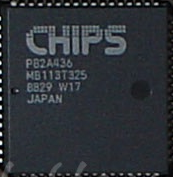 CS8240 Chipset CS8240 Chipset
Launched: 1985
Bus: ISA
The CS8240 chipset was C&T's crowning glory in late 1985. C&T openly stated that it reverse-engineered the [IBM] EGA by removing the silicon chips from their DIP packages and making photographic enlargements of the circuits, then working backwards from the photos to logic diagrams. C&T patterned its own copies with a few changes - all perfectly legal before the Silicon Copyright Act of 1984. One penalty for such slavish copying is that all of IBM's bugs came as part of the package.
The C&T chip set did little to improve on IBM's EGA, which is incompatible with the monochrome adapter and CGA except on a BIOS level.
The CS8240 graphics chipset consisted of these four ICs:
82C431 - Graphics Controller
82C432A - Sequencer
82C433 - Attributes Controller
82C434A - CRT Controller
A number of mid-80s EGA cards made use of this chipset, including:
|
  82C435 Enhanced Graphics Controller (1987) 82C435 Enhanced Graphics Controller (1987)
Launched: 1987
Bus: ISA
Memory: Up to 256 KB in eight 64k x 4 DRAMs
Supports: MDA, Hercules, CGA and EGA.
The 82C435 Enhanced graphics controller chip integrated all four of the earlier CS8240 graphics chipset chips into a single 84-pin PLCC package. Its accompanying bus interface chip, 82A436, handled memory and I/O operations and came in a single 68-pin PLCC.
The 82C435 Enhanced graphics controller and 82A436 bus interface allowed third-party graphics card manufacturers to implement a 100% EGA compatible card with as few as 13 additional components. And in the spirit of IBM compatibility, the card also fully supported the older IBM graphics standards of CGA, Monochrome, and Hercules.
One feature that would be seen on competing products soon after was what C&T called 'Smart Auto-Emulation', which automatically adjusted to the graphics mode required by the application software. It could also handle dynamic reading and writing of registers without being reset, making task-switching/multi-window applications a possibility.
An enhanced CGA mode was also provisioned, allowing the display of CGA text at EGA resolution (640 x 350). In addition, other aspects of the EGA standard including a light pen interface and Feature Connector (for external video, e.g. TV-out) were also included.
The chipset supported a maximum of 256 KB of video memory for EGA modes, comprising up to eight 64k x 4 chips. This permitted resolutions of 640 x 480 in 16 colours, and 800 x 600 (larger than standard EGA, whose max resolution was 640 x 350) - these are sometimes called "Super EGA". 16k x 4 chips were not supported (so a 64 KB card is not supported with this chipset). When run in CGA modes, memory was limited to using 16 KB, and in Monochrome/Hercules text modes it was limited to 4 KB. Memory speeds supported were 100ns, 120ns and 150ns (120ns or faster is required for high-bandwidth CPU modes - see further down).
Graphics Modes supported were:
- Hercules/Monochrome: 40x25/80x25 text modes, Hercules Graphics Mode-Half, Hercules Graphics Mode-Full
- CGA: 40x25/80x25 text modes, 160x100, 320x200, 640x200
- EGA: 320x200, 640x350, 640x480, 800x600
The chipset could be driven at up to 25 MHz dot clock if an external crystal oscillator was employed in the design. When run in 320 x 200 modes, dot clock was halved.
Performance of the 82C435 was excellent as it permitted the CPU two accesses to display memory for every four CRTC accesses, effectively doubling the memory bandwidth available to the CPU (and by translation, updating the screen twice as often). This mode could be used at up to 20 MHz video clock (standard EGA operation runs at 16 MHz).
It was used on the following cards:
Datasheet |
82C441 VGA Controller (1987)
Launched: 1987
Bus: ISA
Supports: MDA, Hercules, CGA, EGA and VGA
The 82C441 was a single-chip solution for graphics card vendors, that provided up to 800 x 560 resolution in 16 colours, and 132-column text mode. It also supported 752 x 410 and the VGA standard of 640 x 480.
It was used on the ATI EGA Wonder VIP. |
82C451 VGA Controller (1990) 
Launched: 1990
Bus: ISA/EISA or MCA
Supports: MDA, Hercules, CGA, EGA and VGA
The 82C451 was a single-chip solution for graphics card vendors, that provided up to 800 x 600 resolution in 16 colours, and 132-column text mode.
Graphics cards that used this chipset include:
Datasheet |
 Chips & Technologies, Inc.
Chips & Technologies, Inc.



